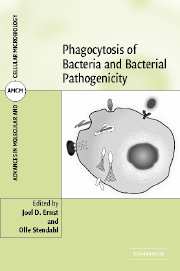Book contents
- Frontmatter
- Contents
- List of contributors
- 1 Introduction
- 2 Phagocytosis: receptors and biology
- 3 Receptor-initiated signal transduction during phagocytosis
- 4 Life, death, and inflammation: manipulation of phagocyte function by Helicobacter pylori
- 5 Phagocytosis of Streptococcus pneumoniae
- 6 Yersinia inhibition of phagocytosis
- 7 Listeria invasion and spread in non-professional phagocytes
- 8 Mycobacterium tuberculosis: mechanisms of phagocytosis and intracellular survival
- Index
- Plate section
- References
4 - Life, death, and inflammation: manipulation of phagocyte function by Helicobacter pylori
Published online by Cambridge University Press: 07 August 2009
- Frontmatter
- Contents
- List of contributors
- 1 Introduction
- 2 Phagocytosis: receptors and biology
- 3 Receptor-initiated signal transduction during phagocytosis
- 4 Life, death, and inflammation: manipulation of phagocyte function by Helicobacter pylori
- 5 Phagocytosis of Streptococcus pneumoniae
- 6 Yersinia inhibition of phagocytosis
- 7 Listeria invasion and spread in non-professional phagocytes
- 8 Mycobacterium tuberculosis: mechanisms of phagocytosis and intracellular survival
- Index
- Plate section
- References
Summary
Helicobacter pylori is a spiral-shaped, flagellated, microaerophilic Gram-negative bacterium that colonizes the gastric epithelium of c.50% of humans (Blaser & Berg 2001). These organisms elicit a strong immune response that does not resolve the infection; once acquired, bacteria persist for a lifetime in the absence of antibiotic treatment. All persons infected with H. pylori have gastritis and 20%–30% will develop severe disease that includes gastric and duodenal ulcers, gastric adenocarcinoma or MALT lymphoma (Covacci et al. 1999). A characteristic feature of H. pylori infection is the massive recruitment of phagocytes (particularly neutrophils) to the gastric mucosa (Allen 2000). Of interest here is the fact that H. pylori survives for years in a phagocyte-rich environment, and a growing body of data demonstrates that these organisms modulate the host inflammatory response and phagocyte function. By this mechanism H. pylori evades phagocytic killing and promotes host tissue damage.
COLONIZATION OF THE GASTRIC EPITHELIUM
Helicobacter pylori is the only microbe that survives in the hostile environment of the human stomach (Blaser & Berg 2001, Montecucco & Rappuoli 2001). Urease is a nickel-containing enzyme that is essential for colonization; ammonia generated by this enzyme buffers H. pylori as it passes through the highly acidic gastric lumen. Bacteria establish residence in the mucus layer over the epithelium; motility in this milieu is enhanced by the spiral shape of the organism and multiple polar flagella.
- Type
- Chapter
- Information
- Phagocytosis of Bacteria and Bacterial Pathogenicity , pp. 91 - 134Publisher: Cambridge University PressPrint publication year: 2006



